Analyzing IKEA's Globalization: Business Management Critical Issues
VerifiedAdded on 2020/11/23
|9
|2557
|390
Report
AI Summary
This report delves into the critical issues IKEA faces in its globalization strategy, examining the drivers behind its international expansion. It analyzes IKEA's approach to entering the Indian market, including the strategies employed, such as cost leadership, differentiation, and focus strategies, to gain a competitive advantage. The report also highlights the bureaucratic and political challenges IKEA encountered in India, such as sourcing regulations, government policies, and cultural considerations, which led to delays and obstacles in establishing its retail presence. Furthermore, the report discusses IKEA's strategies to overcome these challenges, including adapting to local norms and engaging with local communities. The report concludes by summarizing the key findings and emphasizing the importance of understanding and addressing these issues for successful international business operations.

CRITICAL ISSUES IN
BUSINESS MANAGEMENT
BUSINESS MANAGEMENT
Paraphrase This Document
Need a fresh take? Get an instant paraphrase of this document with our AI Paraphraser

TABLE OF CONTENTS
INTRODUCTION..........................................................................................................................1
Main body.......................................................................................................................................1
1. Analysing as well as discussing the drivers of globalization for IKEA.............................1
2 Strategies adopted by the Ikea Company for entering into Indian market..........................2
3 Bureaucratic and political challenges faced by IKEA to gain approval to enter India.......3
CONCLUSION..............................................................................................................................5
REFERENCES...............................................................................................................................6
INTRODUCTION..........................................................................................................................1
Main body.......................................................................................................................................1
1. Analysing as well as discussing the drivers of globalization for IKEA.............................1
2 Strategies adopted by the Ikea Company for entering into Indian market..........................2
3 Bureaucratic and political challenges faced by IKEA to gain approval to enter India.......3
CONCLUSION..............................................................................................................................5
REFERENCES...............................................................................................................................6

INTRODUCTION
Business owner has to face the several critical issues when establishing as well as running
business in international market. The several problems which are faced by an organization in
global environment have direct as well as significant impact on the business performance. The
major issues faced by an enterprise in global environment are high level of competition which
might have negative impact on the sustainability of firm in international market. The positive
effect of globalization is that it has provided organization an opportunity to expand business
operations. The present report has focus on analysing the drivers of globalization in context of
Ikea Company. It also emphasizes on identifying the reason for delay by company in entering
into Indian market.
Main body
1. Analysing as well as discussing the drivers of globalization for IKEA
Globalization is considered to be as complicated procedures, as it involves the quick
social changes. The positive impact of globalization is that it allows firm to expand business.
Negative impact of internalization is that it increases the level of companies which has direct as
well as major effect on business performance. Globalization enables business entities to develop
various abilities and support organization in increasing competitive strength.
Drivers of globalization
There are several drivers of globalization these are:
Customer’s drivers: The purpose of IKEA Company is to cater the need as well as demand of
customer in the market. This factor has encouraged the firm to expand business operation. As
without expanding the core business Activities Company will not be able to fulfil the demand of
customers. It is required by an organization to standardize their goods as per the needs as well as
demand of consumers.
Cost driver: the other important variable which encourages firm to go intrernatio0n is cost. Raise
in the cost of production in domestic country force an organization to enter into new market.
Globalization is the main element which gives rise to cost related issue. Management in Ikea has
planned to use the low pricing strategy which has allowed firm to attract more number of
customers (Deerskin, 2017). This strategy has also provided business entity an opportunity to
further expand its business and enter into new market.
1
Business owner has to face the several critical issues when establishing as well as running
business in international market. The several problems which are faced by an organization in
global environment have direct as well as significant impact on the business performance. The
major issues faced by an enterprise in global environment are high level of competition which
might have negative impact on the sustainability of firm in international market. The positive
effect of globalization is that it has provided organization an opportunity to expand business
operations. The present report has focus on analysing the drivers of globalization in context of
Ikea Company. It also emphasizes on identifying the reason for delay by company in entering
into Indian market.
Main body
1. Analysing as well as discussing the drivers of globalization for IKEA
Globalization is considered to be as complicated procedures, as it involves the quick
social changes. The positive impact of globalization is that it allows firm to expand business.
Negative impact of internalization is that it increases the level of companies which has direct as
well as major effect on business performance. Globalization enables business entities to develop
various abilities and support organization in increasing competitive strength.
Drivers of globalization
There are several drivers of globalization these are:
Customer’s drivers: The purpose of IKEA Company is to cater the need as well as demand of
customer in the market. This factor has encouraged the firm to expand business operation. As
without expanding the core business Activities Company will not be able to fulfil the demand of
customers. It is required by an organization to standardize their goods as per the needs as well as
demand of consumers.
Cost driver: the other important variable which encourages firm to go intrernatio0n is cost. Raise
in the cost of production in domestic country force an organization to enter into new market.
Globalization is the main element which gives rise to cost related issue. Management in Ikea has
planned to use the low pricing strategy which has allowed firm to attract more number of
customers (Deerskin, 2017). This strategy has also provided business entity an opportunity to
further expand its business and enter into new market.
1
⊘ This is a preview!⊘
Do you want full access?
Subscribe today to unlock all pages.

Trusted by 1+ million students worldwide

Competitive driver: Rise in level of competition is another big factor which forces or encourages
an enterprise to expand business. The firm generally plans to enter into new market with
intention of exploring growth opportunities and reducing the effect of completion on
Business performance of Ikea Company has to face competition from both domestic as well as
multinational companies.
Government drivers: Another major element which gives rise to globalization is strict regulation
as well as norms formed by government in the nation. These variables have direct as well as
significant effect on the firm operating at international level (Luthans and Doh, 2018). In
addition to this the other reason for rise in globalization is continuous changes in economic as
well as political factors. In context of IKEA, purpose of the organization is to earn higher profit ,
therefore in order to accomplish this object business owner has decided to expand business.
Reason for IKea company delay in entering into Indian market
There are many issues such as cultural challenges are faced by an organization when
entering into India market. The important reason for delayed by Ikea in Indian market is
management concern about the local sources requirement. In addition to this the another reason
for delay is the strict regulation formed by the government in India related to single brand
retailers which has forced firm to revaluate its plan (Buckley,2017). The other policy or
regulation states that it is compulsory for all organization to supply thirty percent manufactured
products from small firm. There are several hurdles which have to be faced by the IKEA
Company when entering into Indian market these are export barriers, government policies, high
tariff and quotas etc.
2 Strategies adopted by the Ikea Company for entering into Indian market
There many unique strategies have been adopted by Ikea Company for entering into
Indian market. These are;
Cost leadership strategy: The low pricing strategy has been adopted by management in IKEA for
entering into Indian market. This strategy has helped business entity in attracting the more
number of customers. It has also helped firm in gaining the competitive advantage in Indian as
well as other international markets. But still I is required by manager in an enterprise to
formulate other unique as well as effective strategies like low labour cost etc.( Doha and
Benischke,2017) Cost leadership strategy has provided firm an opportunity to achieve leadership
position in international market.
2
an enterprise to expand business. The firm generally plans to enter into new market with
intention of exploring growth opportunities and reducing the effect of completion on
Business performance of Ikea Company has to face competition from both domestic as well as
multinational companies.
Government drivers: Another major element which gives rise to globalization is strict regulation
as well as norms formed by government in the nation. These variables have direct as well as
significant effect on the firm operating at international level (Luthans and Doh, 2018). In
addition to this the other reason for rise in globalization is continuous changes in economic as
well as political factors. In context of IKEA, purpose of the organization is to earn higher profit ,
therefore in order to accomplish this object business owner has decided to expand business.
Reason for IKea company delay in entering into Indian market
There are many issues such as cultural challenges are faced by an organization when
entering into India market. The important reason for delayed by Ikea in Indian market is
management concern about the local sources requirement. In addition to this the another reason
for delay is the strict regulation formed by the government in India related to single brand
retailers which has forced firm to revaluate its plan (Buckley,2017). The other policy or
regulation states that it is compulsory for all organization to supply thirty percent manufactured
products from small firm. There are several hurdles which have to be faced by the IKEA
Company when entering into Indian market these are export barriers, government policies, high
tariff and quotas etc.
2 Strategies adopted by the Ikea Company for entering into Indian market
There many unique strategies have been adopted by Ikea Company for entering into
Indian market. These are;
Cost leadership strategy: The low pricing strategy has been adopted by management in IKEA for
entering into Indian market. This strategy has helped business entity in attracting the more
number of customers. It has also helped firm in gaining the competitive advantage in Indian as
well as other international markets. But still I is required by manager in an enterprise to
formulate other unique as well as effective strategies like low labour cost etc.( Doha and
Benischke,2017) Cost leadership strategy has provided firm an opportunity to achieve leadership
position in international market.
2
Paraphrase This Document
Need a fresh take? Get an instant paraphrase of this document with our AI Paraphraser
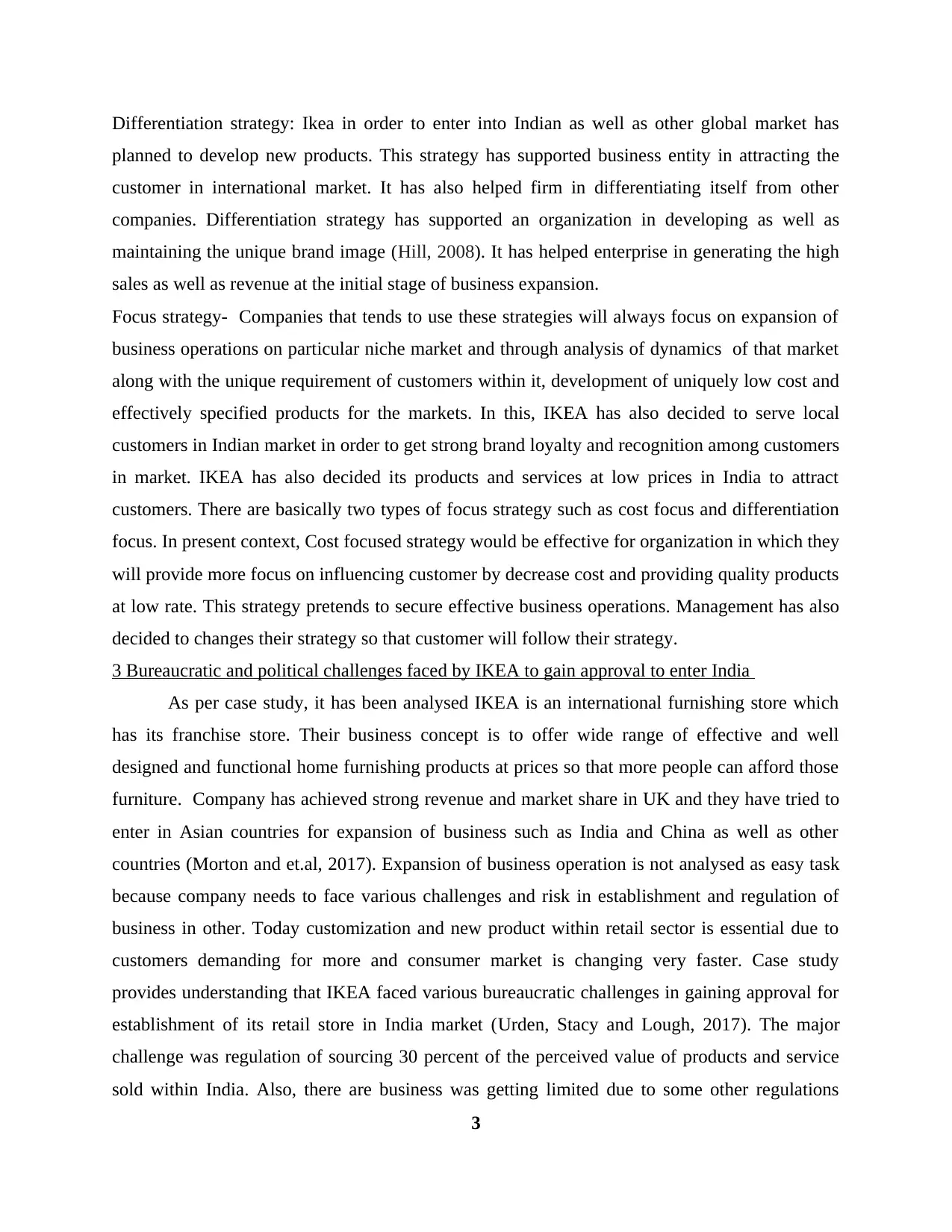
Differentiation strategy: Ikea in order to enter into Indian as well as other global market has
planned to develop new products. This strategy has supported business entity in attracting the
customer in international market. It has also helped firm in differentiating itself from other
companies. Differentiation strategy has supported an organization in developing as well as
maintaining the unique brand image (Hill, 2008). It has helped enterprise in generating the high
sales as well as revenue at the initial stage of business expansion.
Focus strategy- Companies that tends to use these strategies will always focus on expansion of
business operations on particular niche market and through analysis of dynamics of that market
along with the unique requirement of customers within it, development of uniquely low cost and
effectively specified products for the markets. In this, IKEA has also decided to serve local
customers in Indian market in order to get strong brand loyalty and recognition among customers
in market. IKEA has also decided its products and services at low prices in India to attract
customers. There are basically two types of focus strategy such as cost focus and differentiation
focus. In present context, Cost focused strategy would be effective for organization in which they
will provide more focus on influencing customer by decrease cost and providing quality products
at low rate. This strategy pretends to secure effective business operations. Management has also
decided to changes their strategy so that customer will follow their strategy.
3 Bureaucratic and political challenges faced by IKEA to gain approval to enter India
As per case study, it has been analysed IKEA is an international furnishing store which
has its franchise store. Their business concept is to offer wide range of effective and well
designed and functional home furnishing products at prices so that more people can afford those
furniture. Company has achieved strong revenue and market share in UK and they have tried to
enter in Asian countries for expansion of business such as India and China as well as other
countries (Morton and et.al, 2017). Expansion of business operation is not analysed as easy task
because company needs to face various challenges and risk in establishment and regulation of
business in other. Today customization and new product within retail sector is essential due to
customers demanding for more and consumer market is changing very faster. Case study
provides understanding that IKEA faced various bureaucratic challenges in gaining approval for
establishment of its retail store in India market (Urden, Stacy and Lough, 2017). The major
challenge was regulation of sourcing 30 percent of the perceived value of products and service
sold within India. Also, there are business was getting limited due to some other regulations
3
planned to develop new products. This strategy has supported business entity in attracting the
customer in international market. It has also helped firm in differentiating itself from other
companies. Differentiation strategy has supported an organization in developing as well as
maintaining the unique brand image (Hill, 2008). It has helped enterprise in generating the high
sales as well as revenue at the initial stage of business expansion.
Focus strategy- Companies that tends to use these strategies will always focus on expansion of
business operations on particular niche market and through analysis of dynamics of that market
along with the unique requirement of customers within it, development of uniquely low cost and
effectively specified products for the markets. In this, IKEA has also decided to serve local
customers in Indian market in order to get strong brand loyalty and recognition among customers
in market. IKEA has also decided its products and services at low prices in India to attract
customers. There are basically two types of focus strategy such as cost focus and differentiation
focus. In present context, Cost focused strategy would be effective for organization in which they
will provide more focus on influencing customer by decrease cost and providing quality products
at low rate. This strategy pretends to secure effective business operations. Management has also
decided to changes their strategy so that customer will follow their strategy.
3 Bureaucratic and political challenges faced by IKEA to gain approval to enter India
As per case study, it has been analysed IKEA is an international furnishing store which
has its franchise store. Their business concept is to offer wide range of effective and well
designed and functional home furnishing products at prices so that more people can afford those
furniture. Company has achieved strong revenue and market share in UK and they have tried to
enter in Asian countries for expansion of business such as India and China as well as other
countries (Morton and et.al, 2017). Expansion of business operation is not analysed as easy task
because company needs to face various challenges and risk in establishment and regulation of
business in other. Today customization and new product within retail sector is essential due to
customers demanding for more and consumer market is changing very faster. Case study
provides understanding that IKEA faced various bureaucratic challenges in gaining approval for
establishment of its retail store in India market (Urden, Stacy and Lough, 2017). The major
challenge was regulation of sourcing 30 percent of the perceived value of products and service
sold within India. Also, there are business was getting limited due to some other regulations
3
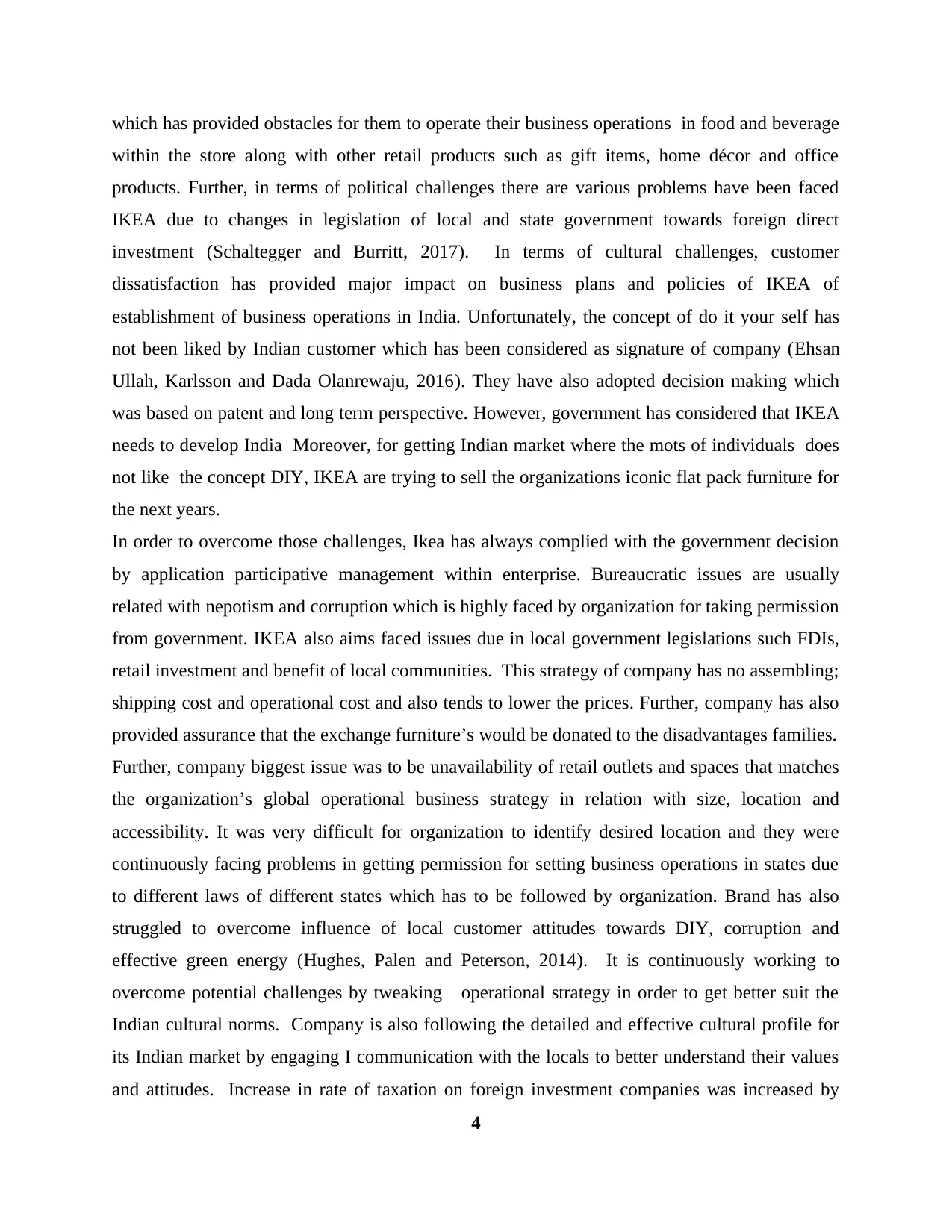
which has provided obstacles for them to operate their business operations in food and beverage
within the store along with other retail products such as gift items, home décor and office
products. Further, in terms of political challenges there are various problems have been faced
IKEA due to changes in legislation of local and state government towards foreign direct
investment (Schaltegger and Burritt, 2017). In terms of cultural challenges, customer
dissatisfaction has provided major impact on business plans and policies of IKEA of
establishment of business operations in India. Unfortunately, the concept of do it your self has
not been liked by Indian customer which has been considered as signature of company (Ehsan
Ullah, Karlsson and Dada Olanrewaju, 2016). They have also adopted decision making which
was based on patent and long term perspective. However, government has considered that IKEA
needs to develop India Moreover, for getting Indian market where the mots of individuals does
not like the concept DIY, IKEA are trying to sell the organizations iconic flat pack furniture for
the next years.
In order to overcome those challenges, Ikea has always complied with the government decision
by application participative management within enterprise. Bureaucratic issues are usually
related with nepotism and corruption which is highly faced by organization for taking permission
from government. IKEA also aims faced issues due in local government legislations such FDIs,
retail investment and benefit of local communities. This strategy of company has no assembling;
shipping cost and operational cost and also tends to lower the prices. Further, company has also
provided assurance that the exchange furniture’s would be donated to the disadvantages families.
Further, company biggest issue was to be unavailability of retail outlets and spaces that matches
the organization’s global operational business strategy in relation with size, location and
accessibility. It was very difficult for organization to identify desired location and they were
continuously facing problems in getting permission for setting business operations in states due
to different laws of different states which has to be followed by organization. Brand has also
struggled to overcome influence of local customer attitudes towards DIY, corruption and
effective green energy (Hughes, Palen and Peterson, 2014). It is continuously working to
overcome potential challenges by tweaking operational strategy in order to get better suit the
Indian cultural norms. Company is also following the detailed and effective cultural profile for
its Indian market by engaging I communication with the locals to better understand their values
and attitudes. Increase in rate of taxation on foreign investment companies was increased by
4
within the store along with other retail products such as gift items, home décor and office
products. Further, in terms of political challenges there are various problems have been faced
IKEA due to changes in legislation of local and state government towards foreign direct
investment (Schaltegger and Burritt, 2017). In terms of cultural challenges, customer
dissatisfaction has provided major impact on business plans and policies of IKEA of
establishment of business operations in India. Unfortunately, the concept of do it your self has
not been liked by Indian customer which has been considered as signature of company (Ehsan
Ullah, Karlsson and Dada Olanrewaju, 2016). They have also adopted decision making which
was based on patent and long term perspective. However, government has considered that IKEA
needs to develop India Moreover, for getting Indian market where the mots of individuals does
not like the concept DIY, IKEA are trying to sell the organizations iconic flat pack furniture for
the next years.
In order to overcome those challenges, Ikea has always complied with the government decision
by application participative management within enterprise. Bureaucratic issues are usually
related with nepotism and corruption which is highly faced by organization for taking permission
from government. IKEA also aims faced issues due in local government legislations such FDIs,
retail investment and benefit of local communities. This strategy of company has no assembling;
shipping cost and operational cost and also tends to lower the prices. Further, company has also
provided assurance that the exchange furniture’s would be donated to the disadvantages families.
Further, company biggest issue was to be unavailability of retail outlets and spaces that matches
the organization’s global operational business strategy in relation with size, location and
accessibility. It was very difficult for organization to identify desired location and they were
continuously facing problems in getting permission for setting business operations in states due
to different laws of different states which has to be followed by organization. Brand has also
struggled to overcome influence of local customer attitudes towards DIY, corruption and
effective green energy (Hughes, Palen and Peterson, 2014). It is continuously working to
overcome potential challenges by tweaking operational strategy in order to get better suit the
Indian cultural norms. Company is also following the detailed and effective cultural profile for
its Indian market by engaging I communication with the locals to better understand their values
and attitudes. Increase in rate of taxation on foreign investment companies was increased by
4
⊘ This is a preview!⊘
Do you want full access?
Subscribe today to unlock all pages.

Trusted by 1+ million students worldwide
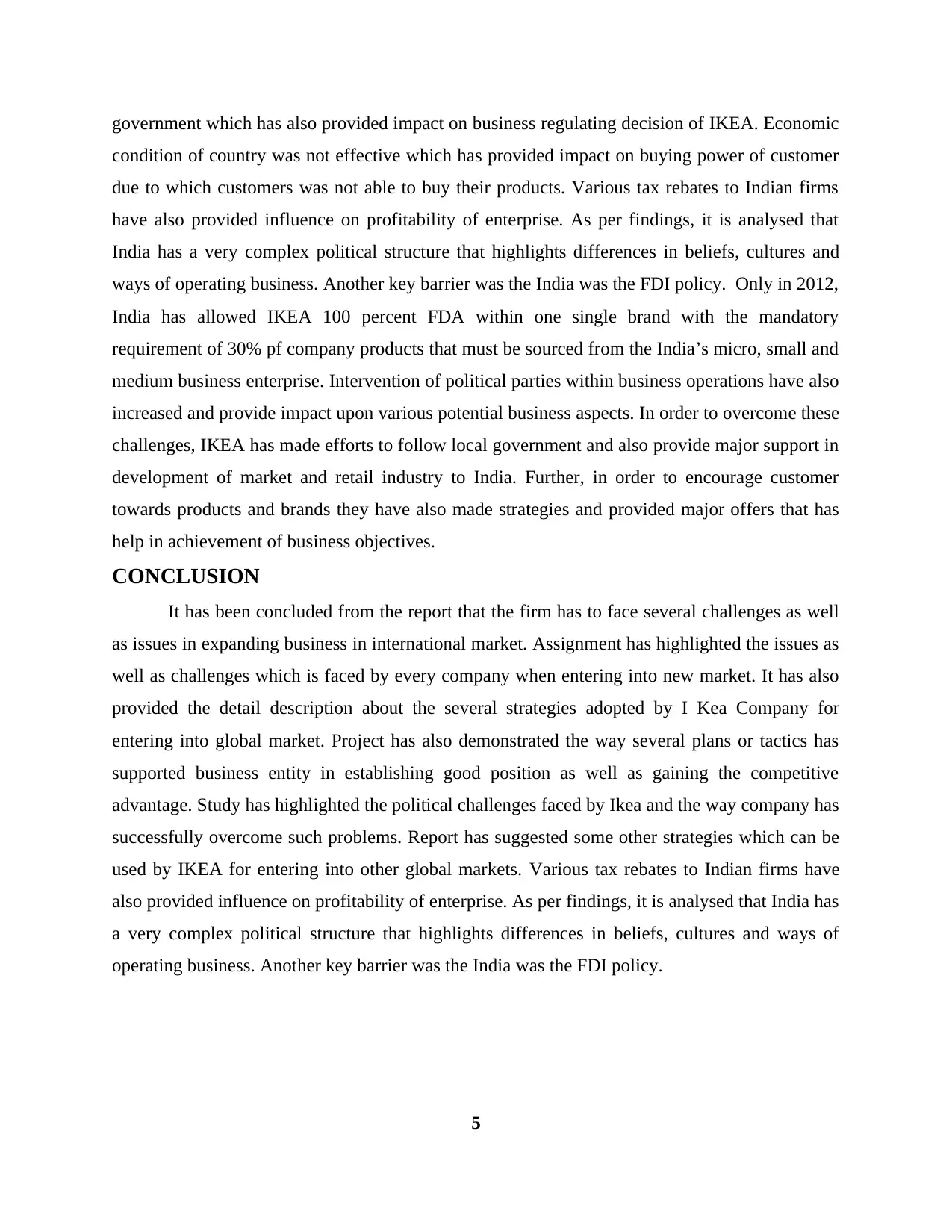
government which has also provided impact on business regulating decision of IKEA. Economic
condition of country was not effective which has provided impact on buying power of customer
due to which customers was not able to buy their products. Various tax rebates to Indian firms
have also provided influence on profitability of enterprise. As per findings, it is analysed that
India has a very complex political structure that highlights differences in beliefs, cultures and
ways of operating business. Another key barrier was the India was the FDI policy. Only in 2012,
India has allowed IKEA 100 percent FDA within one single brand with the mandatory
requirement of 30% pf company products that must be sourced from the India’s micro, small and
medium business enterprise. Intervention of political parties within business operations have also
increased and provide impact upon various potential business aspects. In order to overcome these
challenges, IKEA has made efforts to follow local government and also provide major support in
development of market and retail industry to India. Further, in order to encourage customer
towards products and brands they have also made strategies and provided major offers that has
help in achievement of business objectives.
CONCLUSION
It has been concluded from the report that the firm has to face several challenges as well
as issues in expanding business in international market. Assignment has highlighted the issues as
well as challenges which is faced by every company when entering into new market. It has also
provided the detail description about the several strategies adopted by I Kea Company for
entering into global market. Project has also demonstrated the way several plans or tactics has
supported business entity in establishing good position as well as gaining the competitive
advantage. Study has highlighted the political challenges faced by Ikea and the way company has
successfully overcome such problems. Report has suggested some other strategies which can be
used by IKEA for entering into other global markets. Various tax rebates to Indian firms have
also provided influence on profitability of enterprise. As per findings, it is analysed that India has
a very complex political structure that highlights differences in beliefs, cultures and ways of
operating business. Another key barrier was the India was the FDI policy.
5
condition of country was not effective which has provided impact on buying power of customer
due to which customers was not able to buy their products. Various tax rebates to Indian firms
have also provided influence on profitability of enterprise. As per findings, it is analysed that
India has a very complex political structure that highlights differences in beliefs, cultures and
ways of operating business. Another key barrier was the India was the FDI policy. Only in 2012,
India has allowed IKEA 100 percent FDA within one single brand with the mandatory
requirement of 30% pf company products that must be sourced from the India’s micro, small and
medium business enterprise. Intervention of political parties within business operations have also
increased and provide impact upon various potential business aspects. In order to overcome these
challenges, IKEA has made efforts to follow local government and also provide major support in
development of market and retail industry to India. Further, in order to encourage customer
towards products and brands they have also made strategies and provided major offers that has
help in achievement of business objectives.
CONCLUSION
It has been concluded from the report that the firm has to face several challenges as well
as issues in expanding business in international market. Assignment has highlighted the issues as
well as challenges which is faced by every company when entering into new market. It has also
provided the detail description about the several strategies adopted by I Kea Company for
entering into global market. Project has also demonstrated the way several plans or tactics has
supported business entity in establishing good position as well as gaining the competitive
advantage. Study has highlighted the political challenges faced by Ikea and the way company has
successfully overcome such problems. Report has suggested some other strategies which can be
used by IKEA for entering into other global markets. Various tax rebates to Indian firms have
also provided influence on profitability of enterprise. As per findings, it is analysed that India has
a very complex political structure that highlights differences in beliefs, cultures and ways of
operating business. Another key barrier was the India was the FDI policy.
5
Paraphrase This Document
Need a fresh take? Get an instant paraphrase of this document with our AI Paraphraser
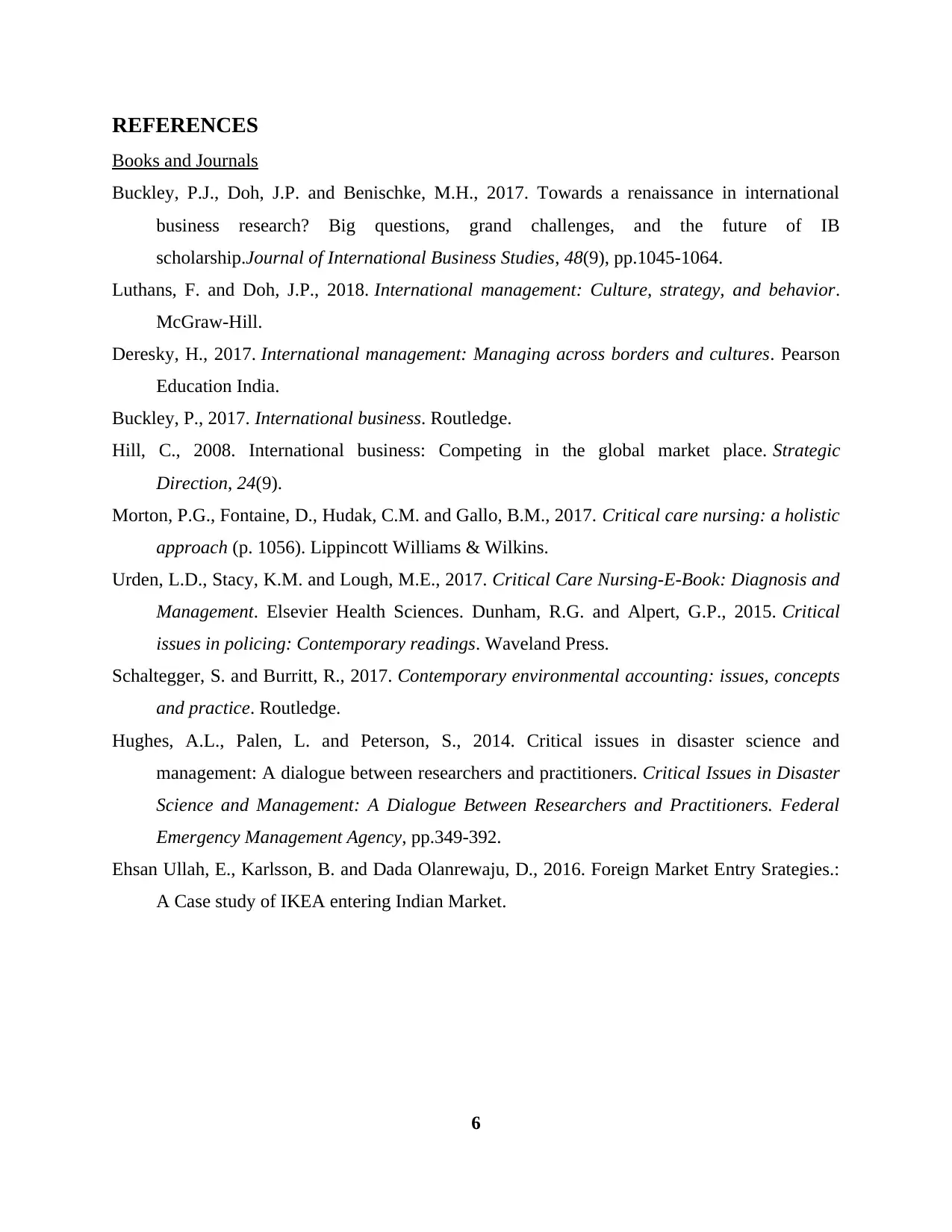
REFERENCES
Books and Journals
Buckley, P.J., Doh, J.P. and Benischke, M.H., 2017. Towards a renaissance in international
business research? Big questions, grand challenges, and the future of IB
scholarship.Journal of International Business Studies, 48(9), pp.1045-1064.
Luthans, F. and Doh, J.P., 2018. International management: Culture, strategy, and behavior.
McGraw-Hill.
Deresky, H., 2017. International management: Managing across borders and cultures. Pearson
Education India.
Buckley, P., 2017. International business. Routledge.
Hill, C., 2008. International business: Competing in the global market place. Strategic
Direction, 24(9).
Morton, P.G., Fontaine, D., Hudak, C.M. and Gallo, B.M., 2017. Critical care nursing: a holistic
approach (p. 1056). Lippincott Williams & Wilkins.
Urden, L.D., Stacy, K.M. and Lough, M.E., 2017. Critical Care Nursing-E-Book: Diagnosis and
Management. Elsevier Health Sciences. Dunham, R.G. and Alpert, G.P., 2015. Critical
issues in policing: Contemporary readings. Waveland Press.
Schaltegger, S. and Burritt, R., 2017. Contemporary environmental accounting: issues, concepts
and practice. Routledge.
Hughes, A.L., Palen, L. and Peterson, S., 2014. Critical issues in disaster science and
management: A dialogue between researchers and practitioners. Critical Issues in Disaster
Science and Management: A Dialogue Between Researchers and Practitioners. Federal
Emergency Management Agency, pp.349-392.
Ehsan Ullah, E., Karlsson, B. and Dada Olanrewaju, D., 2016. Foreign Market Entry Srategies.:
A Case study of IKEA entering Indian Market.
6
Books and Journals
Buckley, P.J., Doh, J.P. and Benischke, M.H., 2017. Towards a renaissance in international
business research? Big questions, grand challenges, and the future of IB
scholarship.Journal of International Business Studies, 48(9), pp.1045-1064.
Luthans, F. and Doh, J.P., 2018. International management: Culture, strategy, and behavior.
McGraw-Hill.
Deresky, H., 2017. International management: Managing across borders and cultures. Pearson
Education India.
Buckley, P., 2017. International business. Routledge.
Hill, C., 2008. International business: Competing in the global market place. Strategic
Direction, 24(9).
Morton, P.G., Fontaine, D., Hudak, C.M. and Gallo, B.M., 2017. Critical care nursing: a holistic
approach (p. 1056). Lippincott Williams & Wilkins.
Urden, L.D., Stacy, K.M. and Lough, M.E., 2017. Critical Care Nursing-E-Book: Diagnosis and
Management. Elsevier Health Sciences. Dunham, R.G. and Alpert, G.P., 2015. Critical
issues in policing: Contemporary readings. Waveland Press.
Schaltegger, S. and Burritt, R., 2017. Contemporary environmental accounting: issues, concepts
and practice. Routledge.
Hughes, A.L., Palen, L. and Peterson, S., 2014. Critical issues in disaster science and
management: A dialogue between researchers and practitioners. Critical Issues in Disaster
Science and Management: A Dialogue Between Researchers and Practitioners. Federal
Emergency Management Agency, pp.349-392.
Ehsan Ullah, E., Karlsson, B. and Dada Olanrewaju, D., 2016. Foreign Market Entry Srategies.:
A Case study of IKEA entering Indian Market.
6
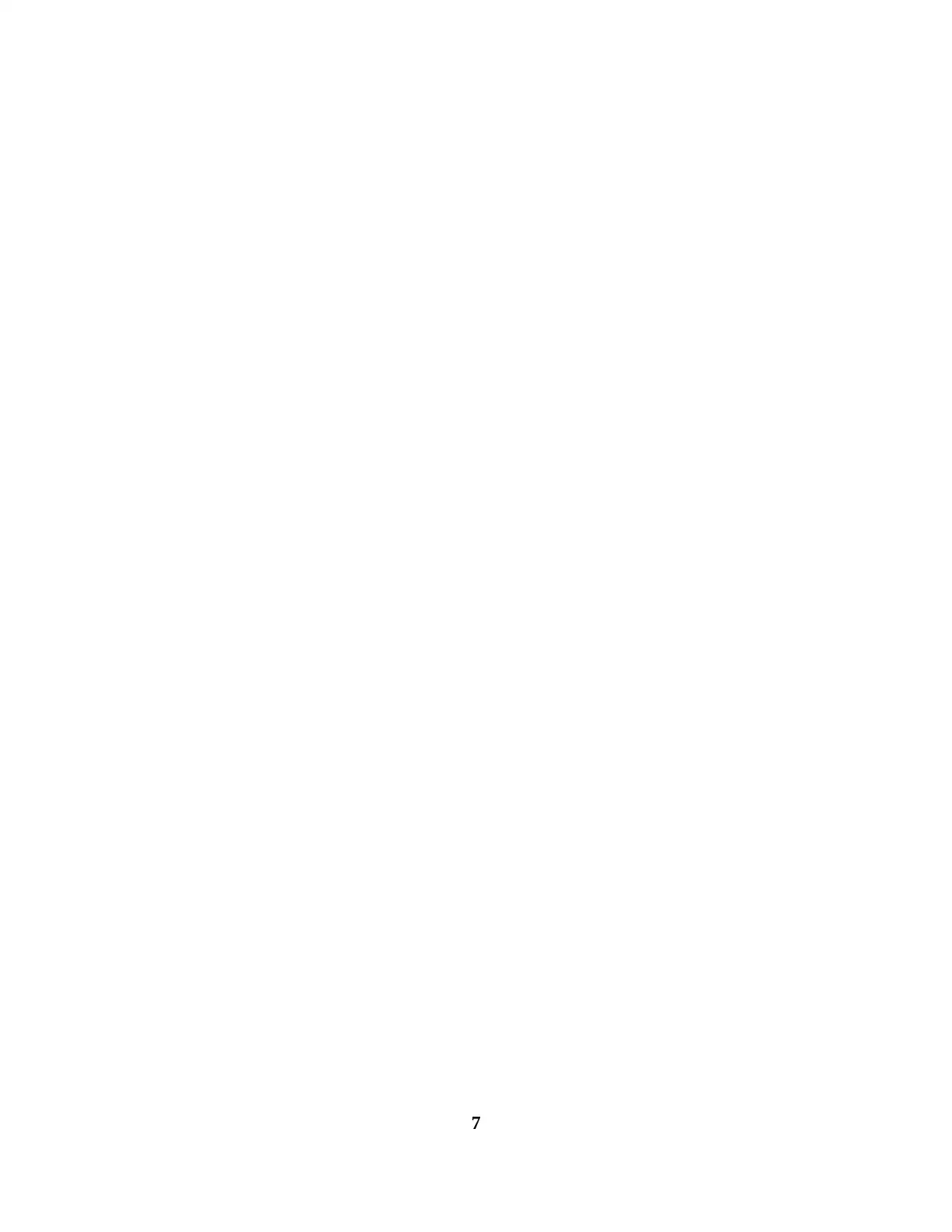
7
⊘ This is a preview!⊘
Do you want full access?
Subscribe today to unlock all pages.

Trusted by 1+ million students worldwide
1 out of 9
Related Documents
Your All-in-One AI-Powered Toolkit for Academic Success.
+13062052269
info@desklib.com
Available 24*7 on WhatsApp / Email
![[object Object]](/_next/static/media/star-bottom.7253800d.svg)
Unlock your academic potential
Copyright © 2020–2025 A2Z Services. All Rights Reserved. Developed and managed by ZUCOL.





